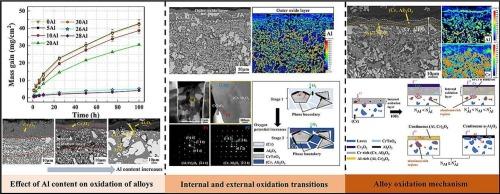加铝Cr-Cr2Ta两相合金的高温氧化行为:铝的影响机理及内外氧化转变的临界条件
IF 4.6
2区 材料科学
Q2 MATERIALS SCIENCE, MULTIDISCIPLINARY
International Journal of Refractory Metals & Hard Materials
Pub Date : 2025-08-17
DOI:10.1016/j.ijrmhm.2025.107381
引用次数: 0
摘要
为了提高Cr-Cr2Ta基两相合金的氧化性能,本研究研究了不同铝添加量对Cr-Cr2Ta基两相合金在1200℃空气中高温氧化行为的影响。在合金氧化过程中,两相边界是铝扩散的主要途径。通过建立铝在(Cr, Al)2O3固溶体氧化层内的扩散模型,计算了Cr- cr2ta两相合金中形成连续α-Al2O3层所需的临界铝浓度。结果表明,合理控制合金中铝的含量有助于提高合金的抗氧化性。铝的加入有效地提高了Cr-Cr2Ta合金的抗氧化性,但过量的铝添加会导致合金基体在氧化过程中出现裂纹,不利于α-Al2O3层保护作用的维持。相反,铝含量接近临界值的合金表现出优异的抗氧化性,并且在整个氧化过程中不会出现开裂。此外,Cr- cr2ta合金中存在固定的铝铬比rAl/Cr∗= 0.45±0.02,这保证了合金表面形成Al2O3层。本文章由计算机程序翻译,如有差异,请以英文原文为准。

High-temperature oxidation behavior of aluminum-added Cr-Cr2Ta two-phase alloys: Mechanism of aluminum influence and critical conditions for internal-external oxidation transition
To enhance the oxidation behavior of Cr-Cr2Ta-based two-phase alloys, this study investigated the effects of varying aluminum additions on the high-temperature oxidation behavior of Cr-Cr2Ta two-phase alloys in air at 1200 °C. During the oxidation of alloys, the two-phase boundary is the main route for aluminum diffusion. By establishing a diffusion model for aluminum within the (Cr, Al)2O3 solid solution oxide layer, the critical aluminum concentration required to form a continuous α-Al2O3 layer in Cr-Cr2Ta two-phase alloys was calculated. The results indicate that a rational control of aluminum content in the alloy significantly aids in enhancing its oxidation resistance. While the addition of aluminum effectively improves the oxidation resistance of Cr-Cr2Ta alloys, excessive aluminum addition leads to cracking in the alloy matrix during oxidation, which is detrimental to maintaining the protective effect of the α-Al2O3 layer. Conversely, alloys with aluminum content near the critical value exhibit excellent oxidation resistance and do not experience cracking throughout the oxidation process. Additionally, a fixed aluminum‑chromium ratio of = 0.45 ± 0.02 exists in the Cr-Cr2Ta alloy, which ensures the formation of an Al2O3 layer on the alloy surface.
求助全文
通过发布文献求助,成功后即可免费获取论文全文。
去求助
来源期刊
CiteScore
7.00
自引率
13.90%
发文量
236
审稿时长
35 days
期刊介绍:
The International Journal of Refractory Metals and Hard Materials (IJRMHM) publishes original research articles concerned with all aspects of refractory metals and hard materials. Refractory metals are defined as metals with melting points higher than 1800 °C. These are tungsten, molybdenum, chromium, tantalum, niobium, hafnium, and rhenium, as well as many compounds and alloys based thereupon. Hard materials that are included in the scope of this journal are defined as materials with hardness values higher than 1000 kg/mm2, primarily intended for applications as manufacturing tools or wear resistant components in mechanical systems. Thus they encompass carbides, nitrides and borides of metals, and related compounds. A special focus of this journal is put on the family of hardmetals, which is also known as cemented tungsten carbide, and cermets which are based on titanium carbide and carbonitrides with or without a metal binder. Ceramics and superhard materials including diamond and cubic boron nitride may also be accepted provided the subject material is presented as hard materials as defined above.

 求助内容:
求助内容: 应助结果提醒方式:
应助结果提醒方式:


